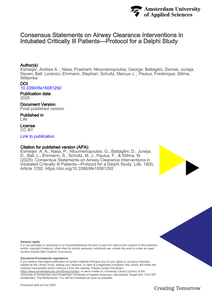Humidification is not a common procedure in many buildings in the Netherlands. An exception are buildings used for healthcare, especially hospitals. There, e.g. in operating theatres, relative humidity (RH) generally is controlled stringently at levels around 50%. From an energy point-of-view humidification is an energy-intensive activity. Currently, more than 10% of the total energy used in healthcare buildings is spent on humidification. The basis for an RH of around 50%, however, is not clear. Therefore, we pursued a scoping review to find evidence for specific RH thresholds in such facilities. In addition, an inventory was made of the current practice in the Netherlands. After analyzing the title and abstracts, the remaining references were read by two persons and scored on several topics. Guidelines and current practice were analyzed by referring to existing (inter)national guidelines and standards, and by contacting experts from Dutch hospitals through a survey and semi-structured interviews. Outcomes from the literature review were grouped into four different topics: 1) micro-organisms and viruses, 2) medical devices, 3) human physiology and 4) perception. No scientific evidence was found for the currently generally applied RH set-point of ~50%. Some studies suggest a minimum RH of 30% but the evidence is weak, with exception of medical devices if specifications require it. A lack of research that addresses more long-term exposure (a couple of days) and includes frail subjects, is noted. It was found that RH requirements are strictly followed in all hospitals consulted, some only focusing on the hot zones, but in many cases extended to the whole hospital. Steam humidification is mostly applied for hygienic reasons. but is quite energy-intensive. The conclusion t is that there is no solid evidence to support the RH-setpoints as currently applied in the Netherlands. It merely appears a code of practice. Therefore, there appears room for quick and significant energy savings, and CO2 emission reductions, when considering control at lower RH values or refraining from humidification at all, while still fulfilling the indoor environment requirements and not negatively influencing the health risk. This outcome can be applied directly in current practice with the available techniques.
LINK
Intubated critically ill patients are susceptible to secretion accumulation because of compromised airway clearance. Various airway clearance interventions are employed to prevent complications arising from mucus retention. This Delphi study aims to collect global opinions in an international expert panel of ICU professionals on the usefulness of these various airway clearance interventions. A steering committee performed a literature search informing the formulation of statements. Statements are grouped into two distinct parts: (1) Humidification and Nebulization, and (2) Suctioning and Mucus mobilization techniques. For each part, a diverse panel of 30–40 experts will be selected, with concerted effort to involve experts from various medical specialties involved in airway clearance methods. Multiple choice questions (MCQs) or 7-point Likert-scale statements will be used in the iterative Delphi rounds to reach consensus on various airway clearance interventions. Rounds will continue until stability is achieved for all statements. Consensus will be deemed achieved when a choice in MCQs or a Likert-scale statement achieves ≥75% agreement or disagreement. Starting from the second round of the Delphi process, stability will be assessed using non-parametric χ2 tests or Kruskal–Wallis tests. Stability will be defined by a p-value of ≥0.05.
DOCUMENT

Airway care interventions may prevent accumulation of airway secretions and promote their evacuation, but evidence is scarce. Interventions include heated humidification, nebulization of mucolytics and/or bronchodilators, manual hyperinflation and use of mechanical insufflation-exsufflation (MI-E). Our aim is to identify current airway care practices for invasively ventilated patients in intensive care units (ICU) in the Netherlands. A self-administered web-based survey was sent to a single pre-appointed representative of all ICUs in the Netherlands. Response rate was 85% (72 ICUs). We found substantial heterogeneity in the intensity and combinations of airway care interventions used. Most (81%) ICUs reported using heated humidification as a routine prophylactic intervention. All (100%) responding ICUs used nebulized mucolytics and/or bronchodilators; however, only 43% ICUs reported nebulization as a routine prophylactic intervention. Most (81%) ICUs used manual hyperinflation, although only initiated with a clinical indication like difficult oxygenation. Few (22%) ICUs used MI-E for invasively ventilated patients. Use was always based on the indication of insufficient cough strength or as a continuation of home use. In the Netherlands, use of routine prophylactic airway care interventions is common despite evidence of no benefit. There is an urgent need for evidence of the benefit of these interventions to inform evidence-based guidelines.
DOCUMENT
